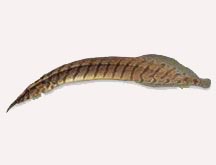Eel - Zig Zag Yellow Tail
Scientific Name: Mastacembelus pancalus
Fri, 11th April, 2025 - 11:21 pm GMT
Sponsor Ads:

Alternative Name
Scientific Name: Mastacembelus pancalusBasic Info
Like all spiny eels the Yellow Zig Zag has spines along its back before the dorsal fin. They are large fish that may reach well over a foot in length at maturity, though they are usually seen between 4 and 6 inches at most hobby shops.
Health
Yellow Zig Zag Eels should be kept at tropical temperatures between 73 and 79 degrees Fahrenheit and the pH levels should be kept between 6 and 8. This species requires a large tank because of their large size. As far as feeding they do best on a diet of live food, which can include bloodworms, brined shrimp, tubifex worms and fish fry. Care of the Yellow Zig Zag is moderately difficult and they may not be the best choice for absolute beginners.Habitat
Fresh water fishBehavior
Yellow Zig Zag Eels belong to a larger family (Mastacembelidae) of fresh water eels called Spiny Eels. There are a variety of different freshwater eels in the Mastacembelidae family, and a number of them are part of the genus Mastacembelus. Many members of this genus are often referred to as the "Zig Zag Eel" and the Yellow Zig Zag is also referred to by this name. Another interesting fact is that even though these fish are called eels, they are not true eels since they are freshwater fish. True eels are marine fish by nature. Yellow Zig Zags grow quite large once they reach maturity and therefore should be housed in large tanks. Most hobbyists recommended a tank no smaller than 50-gallons for mature individuals. Smaller individuals can be housed in 20-gallon tanks, but once they exceed 5 inches in length they will need to be moved into a significantly larger tank. Yellow Zig Zags are relatively peaceful fish, but since they are carnivorous they should not be placed with small fish less than 3 inches in length. They do best in tanks with similarly sized community fish, and some cichlids. They are often shy when they are first placed in tanks, but they usually do quite well after they have had time to adjust to their new surroundings.Origin
Southeast AsiaHistory
This fish is native to South Eastern Asia and most specimens kept in captivity have been wild caught.Common Foods
N/ASponsor Ads:
"There is only one tactical principal which is not subject to change. It is to use the means at hand to inflict the maximum amount of wounds, death, and destruction in the minimum amount of time." - General George S. Patton
Eel - Zig Zag Yellow Tail
Coded by: BGID® | ALL RIGHTS RESERVED Copyright © 2000-2025
Disclaimer | Privacy | Report Errors / Contact | Credits










